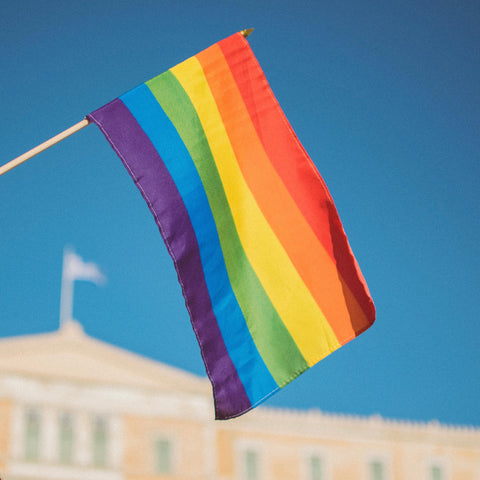Your Cart is Empty
Get Free US Shipping on All Orders $50 or more

Celebrated every June, Pride Month commemorates and honors the members of the LGBTQIA2S+ community and their constant pursuit of dignity, visibility, and acceptance worldwide.
Though the queer community has come a long way in their journey towards acceptance, there are still many large hurdles to overcome and celebrating Pride Month is more important than ever. Education is the enemy of ignorance, so we've put together a how-to guide that covers all the Pride basics so you can stay educated and keep informed about the magical month of June.

Pride didn't begin as marches and pride parades – it began as a protest rather than a celebration, and much of that revolutionary spirit can still be seen in today's pride events.
Throughout history, the queer community has been persecuted and isolated, forcing people to create secret communities and safe havens in bars and restaurants. This was what happened to the Stonewall Inn, which provided a safe space for the LGBTQ community of the Greenwich Village in Manhatten, New York City. At the time, homosexual acts were illegal and bars like Greenwich faced closure if they served the queer community.
On June 28th, 1969, the police raided the Stonewall Inn, harassing and harming patrons and committing hate crimes. Though police raids were a regular occurrence, the queer community within the Stonewall Inn took a stand against the authorities that night. Transgender woman & activist Marsha P. Johnson would throw that first rage-filled brick at the police, lighting the spark that would ignite a riot that would last for 6 days and nights, kick-starting the modern gay liberation movement.
The Stonewall Inn was declared a national monument by the city of New York in 2015 and later named a national monument by Obama in 2016.

One year after Stonewall, a bisexual woman named Brenda Howard planned the first Gay Pride Week & Pride Parade to take New York City (and eventually the world) by storm. An unapologetic and passionate activist, Howard turned a small march into an exponentially growing event that would unify the queer community worldwide. She has thus been dubbed "The Mother of Pride", though there is no recorded history of why the word "Pride" was chosen to represent the Stonewall riots.
When trying to discover the meaning of "Pride", it is often helpful to call back to the word's original meaning and reflect on its representation of the queer community. During the time of the Stonewall riots, many people were being jailed and institutionalized for being gay. Stonewall was a revolt against these forms of political and societal oppression, leading to the vocalization of pride within the queer community rather than hiding away.
The meaning of Pride is different for everyone, especially since its roots began in such a revolutionary way. The Pride March in the modern day is about acceptance and the continuationof the revolution that started over 50 years ago.

Gilbert Baker designed the rainbow flag for the San Francisco Gay Freedom Day Parade celebration on June 25th, 1978, thanks to Harvey Milk, the first openly gay elected official.
It has since undergone many different forms to adjust to the growth and changes within the queer community. More colors were added to represent marginalized people of color, trans people, and those living/that were lost to HIV & Aids. The current Progress Flag was designed in 2018 by Valentino Vecchietti, who added a yellow triangle and purple circle as a tribute to the intersex community.
The queer community is continuously growing, and the LGBTQ Pride Month has grown to include many more members of this beautiful community. Just like queerness, this acronym is constantly shifting and growing to help people describe their experience with gender and sexuality.
Here is an overview of what LGTBQIA2S+ stands for:
Next time your uncle is rolling his eyes at "the gay alphabet," give him a stern reminder that ignorance and oppression lands you on the wrong side of history.
Pride, in its simplest form, is a celebration of queer culture. It is used to uplift the marginalized voices of the LGTBQIA+ community in a political statement that screams,"we have always been here!"It is used to recognize and show appreciation for all the work queer elders have done to pave the way for future generations of queers who will continue to make the world safer for all identities.
Whether you identify as lesbian, gay, bisexual, transgender, or however you want the world to see you, it's important to remember that Pride began as a revolution and continues to be one. So celebrate as loud and proud as you want, and stand tall with your queer community – we'll be standing right beside you.
Celebrating Pride Month is not as simple as wearing a rainbow pin – it is about standing with the queer community in support of all identities and fighting back against those who want to erase their voices from existence.


